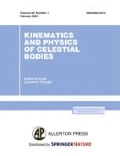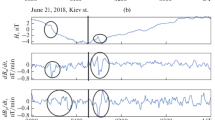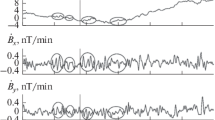Abstract
The magnetic effect of meteors was first observed and theoretically explained back in the middle of the 20th century. The mechanisms for the magnetic effect of large celestial bodies (1–10 m and more) fundamentally differ from the mechanisms of geomagnetic field disturbances caused by meteors at ionospheric heights. The passage of a large meteoroid through the atmosphere and its explosion are accompanied by the generation of a powerful shock wave and the formation of a plume, which result in a geomagnetic effect. To the present day, researchers are divided on the main mechanism for the geomagnetic effect of large meteoroids. The Tunguska and Chelyabinsk meteoroid measurements are available for studies. In the case of the Chelyabinsk meteoroid, the variations in the geomagnetic field are detected and explained both prior to and after the explosion of this celestial body. Analyzing observations of the passage of any large enough celestial body is of considerable theoretical and practical interest. The purposes of this study are to present the analysis of magnetic field variations that arose as a result of the Lipetsk meteoroid passage through the Earth’s magnetosphere and atmosphere and to estimate and discuss the magnetic effect and its mechanisms. The fall rate of such meteoroids is 0.68 yr–1. Using the data provided by the Magnetic Observatory of Karazin Kharkiv National University (Kharkiv, Ukraine), the temporal variations in the horizontal components of the geomagnetic field on June 21, 2018, (the day of the Lipetsk meteoroid passage) and on June 20 and 22, 2018, (the reference days) have been analyzed. The meteoroid’s initial speed was 14.4 km/s, the initial mass was 113 t, and the initial size equaled approximately 4 m. The distance from the observatories to the site where the meteoroid explosion-like release of energy occurred was 360 km. The passage of the Lipetsk meteoroid in the magnetosphere and atmosphere has been shown to be accompanied by alternating variations in the geomagnetic field components. The magnetic effect of the magnetosphere was observed 54–56 min before the meteoroid explosion; the amplitude of the disturbance in the geomagnetic field did not exceed 0.5–1 nT, and the duration was 15–20 min. Alternating spikes (first positive, then negative) in the H and D component level were observed after the meteoroid explosion with a ∼6-min delay. The spike amplitude was ∼1.2–1.5 nT, while the duration of the magnetic effect from the ionosphere reached tens of minutes. The models for the magnetic effects observed are suggested and theoretical estimates are performed. The observations and the estimates are in good agreement.






Similar content being viewed by others
REFERENCES
I. S. Astapovich, Meteor Phenomena in Earth’s Atmosphere (Fizmatgiz, Moscow, 1958) [in Russian].
V. A. Bronshten, Tunguska Meteorite: A History of Research (A. D. Sel’yanov, Moscow, 2000).
V. A. Bronshten, “Magnetic effect of the Tungus meteorite,” Geomagn. Aeron. (Engl. Transl.) 42, 816–818 (2002).
V. D. Gol’din, “On the interpretation of some geophysical phenomena accompanying the fall of the Tunguska meteorite,” in Cosmic Matter and the Earth, Ed. by Yu. A. Dolgov (Nauka, Novosibirsk, 1986), pp. 44–62 [in Russian].
A. V. Zolotov, The Problem of 1908 Tunguska Catastrophe (Nauka Tekh., Minsk, 1969) [in Russian].
K. G. Ivanov, “The geomagnetic phenomena, which were being observed on the Irkutsk magnetic observatory, following the explosion of the Tunguska meteorite,” Meteoritika, No. 21, 46–49 (1961).
K. G. Ivanov, “On the causes of the subsequent field changes in the geomagnetic effect of the Tunguska meteorite,” Geomagn. Aeron. 1, 616–618 (1961).
K. G. Ivanov, “Geomagnetic effects of explosions in the lower atmosphere,” Geomagn. Aeron. 2, 153–160 (1962).
K. G. Ivanov, “Geomagnetic effect of Tunguska event,” Meteoritika, No. 24, 141–151 (1964).
K. G. Ivanov, “Once again on the problem of modeling the geomagnetic effect of the Tungus impact,” Geomagn. Aeron. (Engl. Transl.) 42, 819–820 (2002).
G. M. Idlis and Z. V. Karyagina, “On the cometary origin of the Tunguska meteorite,” Meteoritika, No. 21, 32–43 (1961).
A. G. Kalashnikov, “Observation of the magnetic effect of meteors by the induction method,” Dokl. Akad. Nauk SSSR 66, 373–376 (1949).
A. G. Kalashnikov, “Magnetic effect of meteors,” Izv. Akad. Nauk SSSR, Ser. Geofiz., No. 6, 7–20 (1952).
Catastrophic Events Caused by Cosmic Objects, Ed. by V. V. Adushkin and I. V. Nemchinov, (Akademkniga, Moscow, 2005; Springer-Verlag, Dordrecht, 2008).
A. T. Kovalev, I. V. Nemchinov, and V. V. Shuvalov, “Ionospheric and magnetospheric disturbances caused by impacts of small comets and asteroids,” Sol. Syst. Res. 40, 57–67 (2006).
A. F. Kovalevskii, “Revisiting the problem of geomagnetic effects of large explosions,” Tr. Sib. Fiz.-Tekh. Inst. Tomsk. Gos. Univ. Im. V. V. Kuibysheva, No. 41, 87–91 (1962).
A. F. Kovalevskii, “Magnetic effect of the Tunguska meteorite explosion,” in The Problem of Tunguska Meteorite (Tomsk. Gos. Univ., Tomsk, 1963), pp. 187–194.
O. V. Lazorenko and L. F. Chernogor, Ultra-Wideband Signals and Processes: Monograph (Khark. Nats. Univ. Im. V. N. Karazina, Kharkiv, 2009) [in Russian].
O. A. Molchanov, Low-Frequency Waves and Induced Radiation in the Near-Earth Plasma (Nauka, Moscow, 1985) [in Russian].
G. O. Obashev, “On the geomagnetic effect of the Tunguska meteorite,” Meteoritika, No. 21, 49–52 (1961).
V. M. Sorokin and G. V. Fedorovich, Physics of Slow MHD Waves in the Ionospheric Plasma (Energoizdat, Moscow, 1982) [in Russian].
L. F. Chernogor, “Advanced methods of spectral analysis of quasiperiodic wave-like processes in the ionosphere: Specific features and experimental results,” Geomagn. Aeron. (Engl. Transl.) 48, 652–673 (2008).
L. F. Chernogor, Radiophysical and Geomagnetic Effects of Rocket Engine Burn: Monograph (Khark. Nats. Univ. Im. V. N. Karazina, Kharkiv, 2009) [in Russian].
L. F. Chernogor, “Oscillations of the geomagnetic field caused by the flight of Vitim bolide on September 24, 2002,” Geomagn. Aeron. (Engl. Transl.) 51, 116–130 (2011).
L. F. Chernogor, Physics and Ecology of the Catastrophes (Khark. Nats. Univ. Im. V. N. Karazina, Kharkiv, 2012) [in Russian].
L. F. Chernogor, “Large-scale disturbances in the Earth’s magnetic field associated with the Chelyabinsk meteorite,” Radiofiz. Elektron. 4(18) (3), 47–54 (2013).
L. F. Chernogor, “The main physical effects associated with the Chelyabinsk bolide passage,” in Proc. Asteroids and Comets. Chelyabinsk Event and Study of the Meteorite Falling into the Lake Chebarkul, Int. Sci-Pract. Conf., Cherbakul’, June 21–22,2013 (Krai Ra, Chelyabinsk, 2013), pp. 148–152.
L. F. Chernogor, “Plasma, electromagnetic and acoustic effects of meteorite Chelyabinsk,” Inzh. Fiz., No. 8, 23–40 (2013).
L. F. Chernogor, “Geomagnetic field effects of the Chelyabinsk meteoroid,” Geomagn. Aeron. (Engl. Transl.) 54, 613–624 (2014).
L. F. Chernogor, “Magnetic and ionospheric effects of a meteoroid plume,” Geomagn. Aeron. (Engl. Transl.) 58, 119–126 (2018).
L. F. Chernogor, “Magnetospheric effects during the approach of the Chelyabinsk meteoroid,” Geomagn. Aeron. (Engl. Transl.) 58, 252–265 (2018).
L. F. Chernogor, “Parameters of acoustic signals generated by the atmospheric meteoroid explosion over Romania on January 7, 2015,” Sol. Syst. Res. 52, 206–222 (2018).
L. F. Chernogor, “The physical effects of Lipetsk meteoroid. 1,” Kinematics Phys. Celestial Bodies 35, 174–188 (2019).
L. F. Chernogor, “The physical effects of Lipetsk meteoroid. 2,” Kinematics Phys. Celestial Bodies 35, 217–230 (2019).
L. F. Chernogor, “The physical effects of Lipetsk meteoroid. 3,” Kinematics Phys. Celestial Bodies 35, 271–285 (2019).
L. F. Chernogor and K. P. Garmash, “Disturbances in geospace associated with the Chelyabinsk meteorite passage,” Radiofiz. Radioastron. 18, 231–243 (2013).
L. F. Chernogor, K. P. Garmash, V. A. Podnos, and O. F. Tyrnov, “The V. N. Karazin Kharkiv National University Radio Physical Observatory — The tool for ionosphere monitoring in space experiments,” in Space Project“Ionosat-Micro”, Ed. by S. A. Zasukha and O. P. Fedorov (Akademperiodika, Kharkiv, 2013), pp. 160–182 [in Russian].
P. Brown, R. E. Spalding, D. O. Re Velle, and E. Tagliaferri, “The flux of small near-Earth objects colliding with the Earth,” Nature 420, 294–296 (2002).
Catastrophic Events Caused by Cosmic Objects, Ed. by V. Adushkin and I. Nemchinov (Akademkniga, Moscow, 2005; Springer-Verlag, Dordrecht, 2008). https://doi.org/10.1007/978-1-4020-6452-4
Center for Near Earth Object Studies. https://cneos.jpl.nasa.gov/fireballs/. Accessed March 12, 2019.
L. F. Chernogor and N. Blaunstein, Radiophysical and Geomagnetic Effects of Rocket Burn and Launch in the Near-the-Earth Environment (Taylor & Francis, Boca Raton, FL, 2017).
Infrasound Monitoring for Atmospheric Studies, Ed. by A. Le Pichon, A. Hauchecorne, and E. Blanc (Springer-Verlag, Dordrecht, 2010).
Space Weather Prediction Center National Oceanic and Atmospheric Administration. ftp://ftp.swpc.noaa.gov/ pub/lists/ace2/. Accessed February 18, 2019.
Funding
The study was funded as part of the state budget support of the research activity of institutions of the Ministry of Education and Science of Ukraine, state registration number 0119U002538.
Author information
Authors and Affiliations
Corresponding author
Additional information
Translated by M. Chubarova
About this article
Cite this article
Chernogor, L.F. Geomagnetic Variations Caused by the Lipetsk Meteoroid’s Passage and Explosion: Measurement Results. Kinemat. Phys. Celest. Bodies 36, 79–93 (2020). https://doi.org/10.3103/S0884591320020038
Received:
Revised:
Accepted:
Published:
Issue Date:
DOI: https://doi.org/10.3103/S0884591320020038




